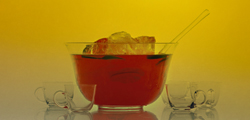Skinny jeans aren’t going away, and the ’80s revival I swore would die four years ago is still going strong. Coca-Cola has even brought back Tab as an energy drink for the ladies. Fine, let’s raise the stakes. The name “Babycham” has been floating around big-city clubs as a moniker for ’80s-themed DJ nights. Babycham is the sparkling English pear cider that was the “in” drink of 1980s London. It’s back—and newly available in this state (currently sold at select Thriftways in 750-milliliter bottles).
Babycham, which is fresher and sweeter than sparkling wine, was the first alcoholic beverage tailored for and marketed to women. The screw-capped green bottle sports a pre–Hello Kitty deer bounding over the logo and leaving a trail of sparkles. The ladies who helped bring Britain through World War II created the first Babycham rage in the 1950s and ’60s, embracing it as an alternative to heavy ales and thick port. Cheeky mod birds were the first to enjoy tiny bottles of this bubbly through a straw. In the ’80s, Babycham became a right of passage for club-going twentysomethings who just wanted to have fun. Equality we ladies may have gained, but light, sweet, sparkly things we will always enjoy.
In honor of the Babycham comet swinging back around, I dug out some old cookbooks to come up with a festive holiday Babycham punch. The Madeira in this recipe adds a rich, ciderlike element to counter the tang of the juices.
Start with one bottle of a medium-sweet or sweeter Madeira, 1 and one-half cups of lemon juice, and 1 cup of pomegranate juice. Then add three bottles of Babycham and a 2-liter bottle of ginger ale. All ingredients should be cold. Mix nonbubbly items first to preserve the carbonation of the bubbly ones. Add the ginger ale last, then taste. If you’d like the punch to be sweeter, stir in some simple syrup (one part water, two parts sugar, simmered just until the sugar crystals have dissolved).
This punch recipe makes 35 to 40 servings, and its alcoholic strength hovers around 6 percent per 6-ounce glass—closer to beer than wine. I always make punch lighter in alcohol as a courtesy to guests. People tend to drink more when they’re out during the holidays, and they drink sweet drinks more rapidly. High-octane punch doesn’t do anyone any favors.
Never add ice cubes to your punch; the cubes melt fast and kill the bubbles. I prefer old-fashioned details such as decorative frozen-fruit molds or floating islands of sherbet. No sorbet, mind you—this is an ’80s flashback. I wonder if the recently published 75th-anniversary edition of The Joy of Cooking still includes directions for an ice punch bowl?





